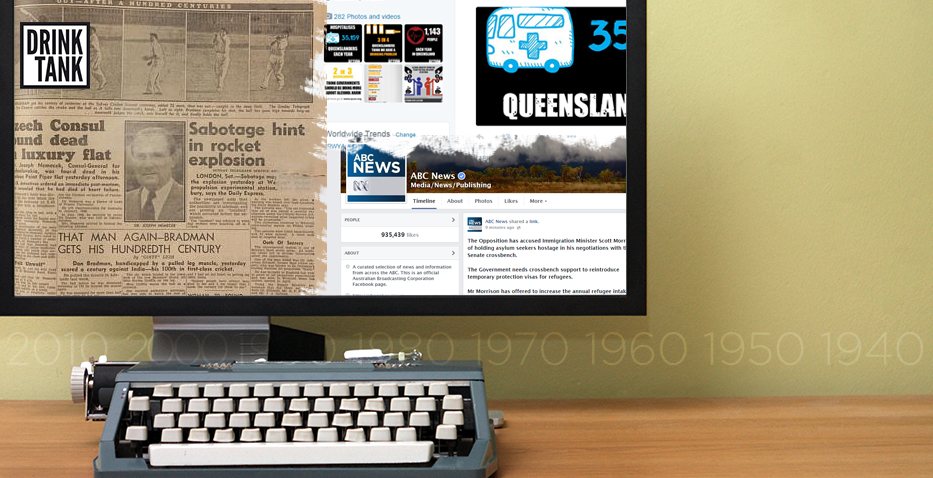Today, much of the important work of journalism is no longer being performed within the traditional institutions of journalism.
So too, audience behaviour is changing. I know from the seismic shift that has occurred in my own news consumption habits. I now rarely visit media websites as a first port of call – receiving most news and content via links circulated on Twitter.
Recently I heard a similar comment made by the editor of a medical student journal – who said her colleagues expected to find journal articles in their social media feeds rather than from journal websites – far less emails or snail mail.
The Post Industrial Journalism report notes that while journalists’ roles are changing profoundly, the biggest changes are occurring in the roles, not of full-time journalists, but of the public, who are sharing, commenting on and helping shape or produce the news.
When I think about the future of journalism and publishing, I am not so much thinking of my role but of you…the reader of this blog and of people like you – who have the capacity and hopefully the passion to undertake some of those roles traditionally associated with journalism.
The notion of networked accountability is not only about you holding governments, corporations and other powerbrokers to account, but also your own fields and organisations – and your own work being held to account.
Recently I had the good fortune to spend a few days on Palm Island, thanks to an invitation from Dr Lynore Geia, a senior lecturer in nursing at James Cook University and a Bwgcolman woman. Lynore has become a colleague and friend arising out of our Twitter connections and engagement.
Palm Island has not been well served by the mainstream media over the years. Amongst other things, Dr Lynore Geia’s PhD thesis makes clear the cumulative impact of negative media coverage upon individuals and communities.
Lynore and I talked about the many challenges the Palm Island community faces – the need to empower youth and the wider community, to create new employment opportunities, and to develop more culturally appropriate and effective services.
So many of our conversations came back to the benefits that might flow from an online local community news site, in providing a platform to give the communities a stronger voice, to hold service providers and governments to account, to create training and employment opportunities, and to share stories.
This, I believe, is one of the futures where public health and public interest journalism may collaborate – in working with local communities to develop new publishing platforms explicitly aimed at meeting those communities’ needs.
It turns out there is a name for all this…
Jeff Jarvis, a thought leader in journalism futures in the US, calls it social journalism, but his definition of social journalism might also work for something that we could call ‘social public health’.
When I first read Jeff Jarvis’ description of social journalism, much of what he described gelled with my experiences in evolving the Croakey blog.
The following Croakey initiatives illustrate the new and emerging possibilities for public health publishing in the digital age.
- Crowd-funding HiAP investigations: Digital engagement identifies new colleagues, new audiences, and new business models – in this case, working with GP Dr Tim Senior, who ran a crowdfunding campaign through the Public Interest Journalism Foundation’s channel on Pozible to fund a regular column at Croakey on the health impacts of policy – #WonkyHealth.
- Crowd-funding as an act of social determination: Gamilaroi writer Kelly Briggs (aka The Koori Woman) chose Croakey as her publishing platform for a regular column on Indigenous health – and raised funds herself to support her doing this, via the IndigenousX channel at the Start Some Good fundraising platform. This is another example of digital engagement bringing new collaborations and opportunities – both for Croakey and Croakey readers, as well as for Kelly.
- The Health Wrap: The Health Wrap is a probono contribution from Kellie Bisset and Frances Gilham at the Sax Institute. Despite adding extra work on top of their very busy schedules at the Sax – their work really adds value for Croakey readers. I always learn new things from the Wrap – illustrating the valuable role of content aggregators and of looking beyond the walls of institutional or disciplinary silos and interests.
- Citizen journalism meets public health: The @WePublicHealth account – a rotated curated Twitter account – has grown quickly since its launch last year, and now has more than 4,000 followers. @WePublicHealth is a fantastic tool for harnessing the collective in sharing news, developing networks and communities of interest. Online connections can be very powerful in developing relationships and networks IRL as well. As a journalist, it is personally one of the more interesting and rewarding things I’ve done. Thanks go to @PeleBennet for launching the account in August 2013, and to the fabulous work of Luke Pearson and @IndigenousX – whose work @WePublicHealth is modelled upon.
This is an edited extract of Melissa Sweet’s presentation to the Public Health Association of Australia (PHAA) conference in Perth earlier this year.








Add comment